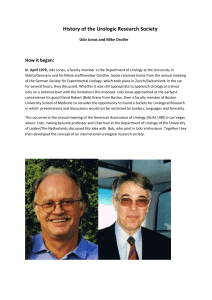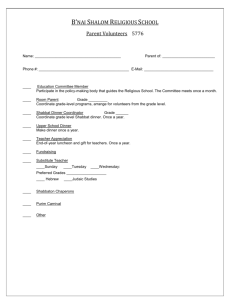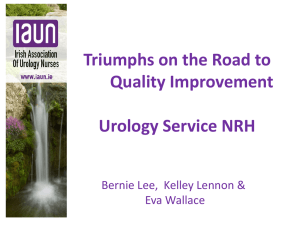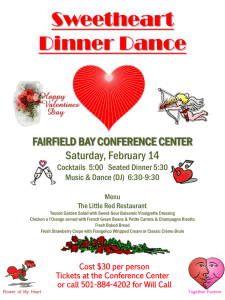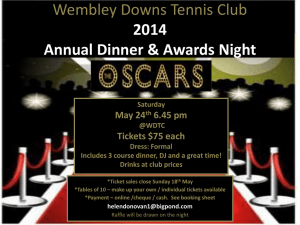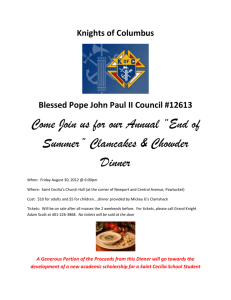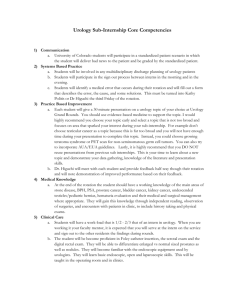A History of the Urologic Research Society
advertisement
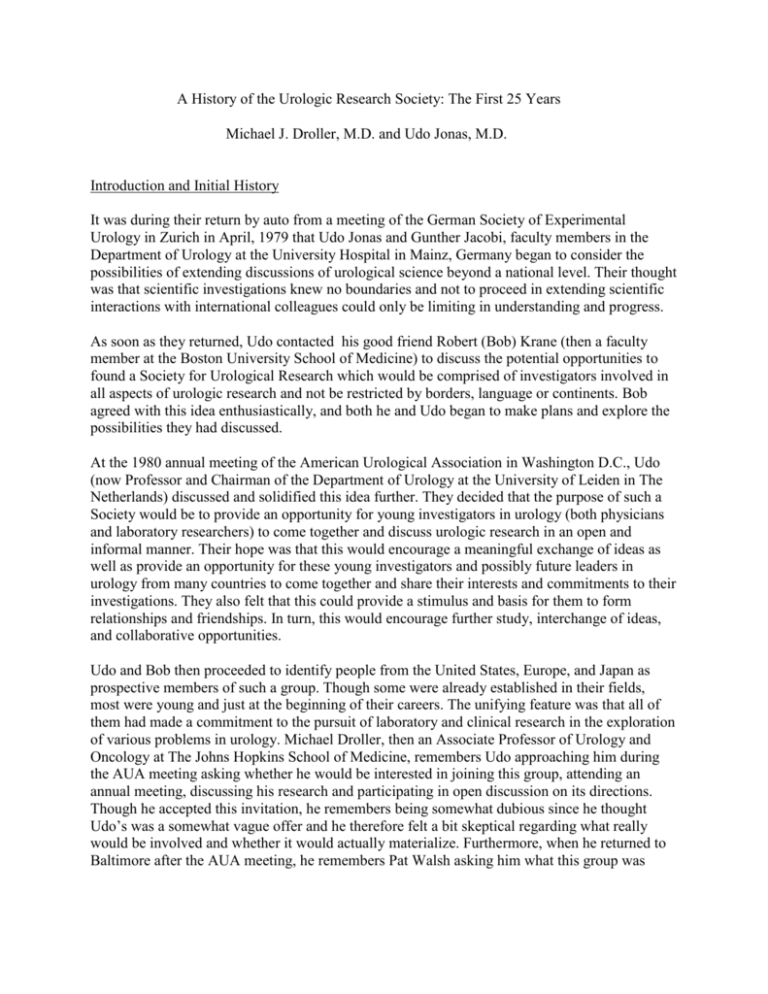
A History of the Urologic Research Society: The First 25 Years Michael J. Droller, M.D. and Udo Jonas, M.D. Introduction and Initial History It was during their return by auto from a meeting of the German Society of Experimental Urology in Zurich in April, 1979 that Udo Jonas and Gunther Jacobi, faculty members in the Department of Urology at the University Hospital in Mainz, Germany began to consider the possibilities of extending discussions of urological science beyond a national level. Their thought was that scientific investigations knew no boundaries and not to proceed in extending scientific interactions with international colleagues could only be limiting in understanding and progress. As soon as they returned, Udo contacted his good friend Robert (Bob) Krane (then a faculty member at the Boston University School of Medicine) to discuss the potential opportunities to found a Society for Urological Research which would be comprised of investigators involved in all aspects of urologic research and not be restricted by borders, language or continents. Bob agreed with this idea enthusiastically, and both he and Udo began to make plans and explore the possibilities they had discussed. At the 1980 annual meeting of the American Urological Association in Washington D.C., Udo (now Professor and Chairman of the Department of Urology at the University of Leiden in The Netherlands) discussed and solidified this idea further. They decided that the purpose of such a Society would be to provide an opportunity for young investigators in urology (both physicians and laboratory researchers) to come together and discuss urologic research in an open and informal manner. Their hope was that this would encourage a meaningful exchange of ideas as well as provide an opportunity for these young investigators and possibly future leaders in urology from many countries to come together and share their interests and commitments to their investigations. They also felt that this could provide a stimulus and basis for them to form relationships and friendships. In turn, this would encourage further study, interchange of ideas, and collaborative opportunities. Udo and Bob then proceeded to identify people from the United States, Europe, and Japan as prospective members of such a group. Though some were already established in their fields, most were young and just at the beginning of their careers. The unifying feature was that all of them had made a commitment to the pursuit of laboratory and clinical research in the exploration of various problems in urology. Michael Droller, then an Associate Professor of Urology and Oncology at The Johns Hopkins School of Medicine, remembers Udo approaching him during the AUA meeting asking whether he would be interested in joining this group, attending an annual meeting, discussing his research and participating in open discussion on its directions. Though he accepted this invitation, he remembers being somewhat dubious since he thought Udo’s was a somewhat vague offer and he therefore felt a bit skeptical regarding what really would be involved and whether it would actually materialize. Furthermore, when he returned to Baltimore after the AUA meeting, he remembers Pat Walsh asking him what this group was about (Pat had also been approached as a prospective member) and suggested that he had doubts about what would actually come of it. The objectives of this new Urological Research Society were that members of this group should be actively engaged in research, have a broad geographic distribution, be involved in and represent the various subspecialty areas in urology, be at a formative phase in their careers, and have already been recognized through their work and publications as being productive and show promise of becoming leaders in their areas of interest. These objectives made this a unique society from its very beginning. No other society fulfilled all of these requirements. Indeed, most research societies were comprised of individuals who had already become well-established and had already been identified as leaders in urology. None represented a broad geographic distribution. And, though some attempted to encourage open exchange of information through informal discussion of research presentations at their meetings, none were sufficiently informal in their structure and through their membership to truly foster such open discussion or to encourage constructive critiques of the work that was being done. Within this context, 33 individuals were asked to join as founding members of what was to become the Urological Research Society (Table 1): Table 1: Founding members of the Urologic Research Society (1980) Rolf Ackermann, M.D., University of Wurzburg, Wurzburg, Germany George Bartsch, M.D., Academische Universitatsklinik, Innsbruck, Austria William J. Catalona, M.D., Washington University, St. Louis, MO Geoffrey D. Chisholm, M.D., University of Edinburgh, Edinburgh, Scotland Donald S. Coffey, Ph.D., Johns Hopkins School of Medicine, Baltimore, MD B.L.R.A. Coolsaet, M.D., University of Utrecht, Utrecht,The Netherlands Michael J. Droller, M.D., Johns Hopkins School of Medicine, Baltimore, MD William R. Fair, M.D., Washington University School of Medicine, St.Louis, MO John M. Fitzpatrick, M.D., University College, Dublin, Ireland Reza Ghanadian, M.D., Clinical Research Laboratory, London, England Donald P. Griffith, M.D., Baylor Univestiy School of Medicine, Houston, TX Richard Hautmann, M.D., University of Aachen, Aachen, Germany Yoshiko Hirao, M.D., University of Nara, Nara, Japan Udo Jonas, M.D., University of Leiden, Leiden,The Netherlands Tadeo Kakizoe, M.D., University of Tokyo, Tokyo, Japan Daniel P. deKlerk, M.D., University of Cape Town, Cape Town, South Africa Robert J. Krane, M.D., Boston University School of Medicine, Boston, MA Paul H. Lange, M.D., University of Minnesota, Minneapolis, MN Larry I. Lipshultz, M.D., Baylor University School of Medicine, Houston, TX Michael Marberger, M.D., Academische Universitatsklinik, Vienna, Austria Carl A. Olsson, M.D. Columbia College of Physicians and Surgeons, New York, NY David F. Paulsen, M.D., Duke University School of Medicine, Durham, NC Philip A. Ransley, M.D., University College London, London, England Martin I. Resnick, M.D., Case-Western Reserve University, Cleveland, OH Richard Schmidt, M.D., University of California, San Francisco, CA Fritz H. Schroeder, M.D., University of Rotterdam, Rotterdam,The Netherlands Claude A. Schulman, M.D., Hopital Erasme, Brussels, Belgium Theo Senge, M.D., Herne Ruhruniversitat, Bochum, Germany Mark S. Soloway, M.D., University of Tennessee, Memphis, TN Emil A. Tanagho, M.D., University of California, San Francisco, CA E. Darracott Vaughan, M.D., New York Hospital, New York, NY Hermann J. de Voogt, M.D., University of Amsterdam, Amsterdam, The Netherlands Alan J. Wein, M.D., University of Pennsylvania, Philadelphia, PA The first meeting of this new Society was held in Leiden, The Netherlands and was hosted by Udo Jonas and his wife, Britta. Fifteen of the founding members attended the first meeting, held on August 29, 1981 (Figure ). This meeting generated the beginnings of an enthusiasm for having such a society because of the opportunities it created to meet new colleagues, discuss research projects, and develop social interactions across international borders. Excitement of the venue and the possibility of seeing the home city of each host added to this. Testimony of this is seen in the first group photo of the new Society (Figure ) and a document with the signatures of the founding members who were able to participate (Figure ). Unfortunately, the bad weather interfered a bit in Udo being able to show the beauty of the Netherlands landscape during a cruise on the lake “Kaag” (Figure ), but it didn’t dampen the enthusiasm of all who attended and brought this message back with them. Following this, it became apparent to Udo that this new Society needed a logo. In the role of Secretary, a position he held for the next 15 years, Udo asked a friend to design a logo which would represent the concepts embodied by the group. The first draft (Figure ) was circulated to the membership for comments and suggestions. The most original came from Don Coffey who integrated the specific urologic symbols, facetiously added a financial component in the “$” sign, and described the aim of the Society to represent “yoU aRe uS”. The second meeting, hosted by Bob Krane and his wife Bambi in Boston immediately following the AUA meeting in Kansas City in 1982, continued the momentum that the first meeting had created and attracted both members and invited guests (Figure ). A highlight was an opening banquet during which Don Coffey, dressed in colonial garb to represent the host city of Boston (Figure ), performed a magic show, this setting the tone for the conviviality that was to continue through the next day’s scientific presentations and open informal discussions. All of this demonstrated the value of the social interactions in establishing new contacts and encouraging productive interactions and discussions. This meeting also continued the precedent for individuals to host the Society in their home city and at their home institutions, to underscore the value of open and incisive discussions such as did not occur at more formal meetings, and to allow time for social activities that encouraged opportunities for openness and the development of new friendships. Although these first meetings initiated the Society and created an initial momentum, its foundation was provided a significant impetus with the third meeting, hosted by Dr. Rolf Ackermann in Wurzburg in 1983. The charm of this city and the wonderful venues at which the meeting and the social events were held, its taking place in the summer which allowed members to bring their spouses and in some cases their children, and the general enjoyment overall set a standard that would be followed at subsequent meetings. Articles of Association The original registration of the Association as the “Urological Research Society” was made in the certification of an "Articles of Association" by Drs. Rolf Ackermann, Fritz H. Schroeder, Udo Jonas and Theo Senge with the German government in Bad Windsheim, Germany on April 26, 1983 (subsequently, a translation in English was certified in Dusseldorf, Germany on June 15, 1987) (Figure ). The expressed object and purpose of the Society was "to promote experimental and clinical research in the field of urology... to be realized by organizing an annual meeting and by promoting the exchange of ideas and of experience gained by the members." As a non-profit organization, the funds of the Association were to be expended exclusively to fulfill the objectives of the Articles of Association. If the Association were ever dissolved, its funds were to revert to the German Urological Association to be used exclusively for charitable purposes to benefit the public. As part of the registration process it was decided that meetings be held once a year, with extraordinary meetings being held as necessary. Additionally, it was decided that “a majority of three-quarters of valid votes be cast for any resolutions to change the objectives of the Association or to amend the Articles of the Association”. Seven members signed the document in Wurzburg on March 25, 1983. For legal purposes, it was decided that the Society should have its seat in Wurzburg. By-Laws A preliminary presentation of by-laws stated that "any person or public body in Germany or abroad shall be eligible for membership...(which) will be acquired on proposal in writing by members, subject to a majority vote of a meeting of members". An Executive Committee, comprised of a Chairman, Vice-Chairman, Treasurer, and Secretary was formed, to be "elected for a two year term by a meeting of members". Initial criteria for membership required proposal in writing by a member, subject to a majority vote by the membership. Changes to the by-laws and to membership were to be accomplished by a three-quarters majority membership vote. In 1986, an expansion and formalization of By-Laws was proposed by Dr. Michael Droller (Appendix C). The purposes of the Society were "to bring together individuals active in all areas or research in urology...(for the) exchange of information and ideas." Membership was to comprise several categories. Active members consisted of Charter members (as listed in the original document) and new members, to be elected by two-thirds of the voting membership a year after candidates had participated in the previous URS meeting. Emeritus members were those members who had reached the age of 50. The total number of active members was proposed to be 40. Suggestions for the election of officers (President, President-Elect, Vice President, Secretary, and Treasurer), creation of a Board of Directors comprised of the Executive Committee of the Officers and five other elected members, and delineation of the duties and responsibilities were included but not formally acted upon, pending further discussion and deliberation by the membership. Proposals for the creation of several standing committees (By-Laws, Budget and Finance, Membership, and Editorial) were also brought up for consideration. Recognition of the World Journal of Urology as the official publication of the Society was also incorporated into the proposed By-Laws. In the ensuing years, most of the discussions at the Society's business meetings involved selection of sites for future meetings and selection of new members, with little concern towards formally adopting a new set of by-laws. However, because of lagging attendance at successive meetings as the founding members assumed leadership positions in their own institutions, as increasing personal obligations and responsibilities interfered with their attending URS meetings, and as a proliferation of specialty meetings consumed the time of many of the younger members, the viability of the Society was called into question. It therefore became important to re-define certain of the processes by which the Society functioned and to re-visit the by-laws as well as the premise for the Society's existence. Much of the focus at this time was on the membership process, what procedures should be followed in terminating membership of a member failed to attend a certain number of consecutive meetings (first two, then three) without an accepted excuse, and the identification of new young investigators in urology who would rejuvenate the Society and pursue the objectives that had initially led to the Society's success. At the URS meeting in Brussels in 1996 the membership decided to adopt a by-laws in which an important part would be a restructuring of the membership process (Appendix D). It was suggested that the membership process used by the American Association of Genitourinary Surgeons be adopted for the Society, both in electing new members and in terminating membership for failure to attend meetings of the Society. A membership committee (Drs. Laurent Boccon-Gibod, Yoshihiko Hirao, and Michael J. Droller) was created to review applications for new members for presentation at the next business meeting of the Society. A new by-laws (Appendix D), incorporating the suggestions of the membership, was reviewed at the meeting in Quebec City in 1997. The major changes implemented included that membership in the Society be limited to 75, that new members who had distinguished themselves in urological research had to be less than 45, that active members who had reached the age of 55 would become fellows, and that those who reached the age of 65 would become emeritus members. A membership committee, comprised of 5 members of the Society would review candidates for membership, candidates would have been invited to attend a meeting of the Society, and their election to membership would require approval by two-thirds vote of active members attending the business meeting during which their candidacy was being considered. Officers of the Society would comprise a President (one year term), a President-elect (one year term), a Secretary (four year term), and a Treasurer (four year term). An Executive Council would be comprised of the four officers of the Society, the immediate Past-President, and a Member-at-Large elected by the active members. Standing committees included those for By- Laws, Budget and Finance, Membership, and Nominating (replacing Editorial). These by-laws were adopted at the 1998 meeting of the Society in Nara, Japan. The World Journal of Urology Having established a well-functioning scientific society with high standards, it seemed logical to involve the members of the URS in the founding and publication of a new international journal that would represent through publication of original and review articles the objectives of the Society. Therefore, just before the third meeting of the Society in Wurzburg in 1983 Drs. Udo Jonas and Robert Krane introduced The World Journal of Urology to serve as the official journal of the Society. The members of the URS would become the Editorial Board while Udo and Bob would become the Editors-in-Chief. Objectives of the new journal were to present basic and clinical research in all subspecialty areas of urology with guest editors selected to lead in the presentation of review articles and original investigations. The Journal was successfully launched with Springer Verlag as its publisher. By 1996 its subscriptions had reached 650-700. At this point discussions regarding possibilities of involving the Journal with the Societe Internationale d’Urologie did not materialize. The impact factor has ranged between 1.2-1.3, placing if fourth amongst urology journals. Subscriptions have remained level at ~450-500 reflecting fewer library subscriptions and increasing use of internet access. Meetings through the First 25 Years of the URS From the time of its establishment in 1980 and then its first meeting in Leiden in 1981, the Urological Research Society has had 18 meetings through 2004 (Appendix B). With adoption of its first set of by-laws in 1985 and subsequent modifications (the most recent being in 1999), creation of the URS logo, and the launching of the World Journal of Urology in 1982 as the official journal of the Society, the URS has become a robust Association, fulfilling its original mission and the vision that its founders had. This History of the Urological Research Society has been written to commemorate the Society's celebration of its first 25 years. It has also been written in honor of Dr. Robert Krane, who together with Dr. Udo Jonas had the vision and the leadership to found this Society. Sadly, Bob passed away in 2003 after suffering through a short but devastating illness. This History is dedicated to Bob in behalf of all of the members of the Society, who admired Bob as their colleague and felt privileged to enjoy Bob as their friend. Table 2: Urological Research Society Meetings Date 1981 1982 1983 Place Leiden,The Netherlands Boston, Massachusetts Wurzburg, Germany Hosts (with wives) Dr. Udo Jonas (Britta) Dr. Robert Krane (Bambi) Dr. Rolf Ackermann (Christl) 1984 1985 1986 2001 Dr. David Paulsen (Pat) Dr. George Bartsch (Heidi) Dr. Michael Droller (Esther) Dr. William Fair (Mary Ann) Dr. E. Darracott Vaughan, Jr. (Anne) Dublin, Ireland Mr. John Fitzpatrick (Carol) Palm Beach, Florida Dr. Alan Wein (Christine) Hanover, Germany Dr. Udo Jonas (Britta) Hilton Head, South Carolina Dr. Martin Resnick (Vicki) Munich, Germany Dr. Rudolf Hartung (Angela) Ayres Rock, Australia Dr. Villus Marshall Brussels, Belgium Dr. Claude Schulman Quebec City, Quebec Dr. Yves Fradet (Denyse) Nara, Japan Dr. Tadeo Kakizoe (Akiko) Dr. Yoshihiko Hirao (Kazuko) Bordeaux, France Dr. Laurent Boccon-Gibod (Liliane) Washington, D.C. Dr. Cully Carson (Mary Jo) Dr. Craig Donatucci Izmir, Turkey Dr. Ziya Kirkali (Gul) 2002 York, United Kingdom 2004 Seoul, Korea 2005 Boston, Massachusetts 1987 1989 1990 1992 1993 1994 1996 1997 1998 1999 2000 Durham, North Carolina Innsbruck, Austria New York, New York Dr. Christopher Chapple (Mary) Dr. Freddie Hamdy (Bettina) Dr. Wun-Jae Kim Dr. Hanjong Ahn Dr. Richard Babayan (Sonya) Meetings and Vignettes 1. Leiden,The Netherlands, August 1981 (hosted by Dr. Udo and Britta Jonas) As described earlier, this initial meeting of the URS took place in Leiden, The Netherlands, and was attended by 15 members. The venue was the Academic Hospital of the University of Leiden. This was the meeting that showed how discussions at a high scientific level could take place in a friendly and warm atmosphere and in which colleagues could gather to meet and present their scientific work and leave as friends (Figures ). 2. Boston, Massachusetts, May 1982 (hosted by Dr. Robert and Bambi Krane) At this second meeting of the URS, many of the founding members of the Society, as well as others who had heard about this new Society, attended. The venue was the Copley Plaza Hotel. An evening banquet was highlighted by Dr. Don Coffey’s magic tricks with Don dressed in colonial costume to create an especially enjoyable atmosphere. Although many were a bit tired after having attended the AUA meeting in Kansas City just before coming to Boston, they were all able to contribute to an active scientific program held the following morning (Figures ). 3. Wurzburg, Germany, June 1983 (hosted by Dr. Rolf and Christl Ackermann) This meeting was felt to establish the tone of the Society and succeeding meetings. Since it was a summer meeting, many of the attendees took advantage of this to bring spouses, and in some instances children, to participate in the social program. A large attendance comprised not only of members of the Society but also of non-members made the two-day scientific session and discussions particularly robust. The setting for the scientific program was a castle. The evening's dinner was held in the wine cellar of the Juliuspital. The following evening's dinner was held in the Princebishop’s Palace (Residenz) after the attendees had enjoyed a formal concert. The dinner speech with the title “Oncogenes: Enemies or Friends in Us?” was given by Professor Eberhard Wecker, Chairman of the Department of Immunology and the University of Wurzburg. The tremendous enjoyability of the social program and the enthusiasm of all all of the attendees and their spouses seemed to create the ambience of a family event even in the context of the scientific excellence of the presentations. Together, this created a wonderful momentum for the Society and support of its concept and objective of creating an opportunity for both scientific exchange and meaningful social interactions to enhance the scientific purpose of the meeting (Figures ). 4. Durham, North Carolina, May, 1984, Dr. David and Pat Paulson This meeting provided an additional social ambience because the receptions and dinners were held at the home of the Paulsons and at the Searle Conference Center at Duke University Medical Center. Proximity of the meeting to the earlier AUA meeting allowed many members and non-members to attend and participate in the scientific program as well (Figures ). The logo for the Urological Research Society as presented by Dr. Udo Jonas was approved by the membership (Appendix E). Several new members were elected, and a number of founding members resigned on account of their not being able to attend the Society's annual meetings with regularity. It was proposed that members of the Society could represent the same institution as long as their work was in different subspecialty areas, that each member could bring a guest to participate in each meeting's scientific program, and that the host of a particular meeting could invite an unlimited number of their home faculty. It was also proposed that a by-laws be drafted, which would include formation of a number of committees to deal with the business of the Society. 5. Innsbruck, Austria, June, 1985, Dr. George and Heidi Bartsch This meeting was held in Innsbruck immediately following the meeting of the Societe Internationale d'Urologie in Vienna. Advantage was taken of the Old World beauty of Innsbruck by a walk through the Old Town to begin the social activities. Dr. George Bartsch arranged for a cable car visit to the Hafelekar (8000 ft) for lunch the first day with an exhibition of hang gliders flying down from the mountaintop to the town of Innsbruck. The group then travelled by tram to Lans for a formal dinner. The next day, the group visited the Hofkirche (The "Blackman's" Church) for an organ concert followed by a banquet at the Hofburg (with surrounding royal portraits, crystal chandeliers, and all of the elegance that is part of a royal castle). All of these encouraged the type of social interactions that enhanced the scientific sessions as well as the informal discussions of work that was presented and ideas proposed for further study (Figures ). At this meeting, the membership number stood at 35, with representation from 10 countries on 5 continents. Suggestions for new members were considered for invitation and participation in the following year's meeting (planned for New York in conjunction with the AUA meeting). An Executive Committee was formed with Dr. Udo Jonas as Chairman, Dr. Robert Krane as Vice Chairman, Dr. David Paulson as Treasurer, and Mr. John Fitzpatrick as Secretary. A Membership Committee chaired by Dr. Michael Droller was also formed, with further guidelines for the membership process reviewed. A possible affiliation with the Societe Internationale d'Urologie was deferred for later consideration. The elegance of the social program and the involvement of spouses in the planning of the meetings and in accompanying members to the meetings increased the warmth of interactions and the friendships that were being formed amongst the members. This atmosphere was fostered by the attention that Brita Jonas, Bambi Krane, Cristl Ackermann, Pat Paulson, and Heidi Bartsch gave to the planning of the social aspects of the meetings and the warm hospitality that they provided, establishing important precedents for subsequent meetings to follow. 6. New York, New York, May, 1986, Dr. Michael and Esther Droller, Dr.William and Maryann Fair, and Dr. E. Darracott and Anne Vaughan, Jr. This meeting immediately followed the annual meeting of the AUA held in New York. Hosting was shared by Drs. Michael Droller, William Fair, and Darracott Vaughan representing Mount Sinai Medical Center, Memorial Sloan Kettering Cancer Center and New York Hospital-Cornell Medical Center respectively. Most of the attendees moved from the Hilton Hotel (the AUA convention hotel) to the Stanhope Hotel situated across the street from the Metropolitan Museum of Art. The first night's dinner was held at the New York Yacht Club, hosted by Dr. Carl and Mary Olsson. He, Dr. James Glenn and Dr. Don Coffey gave wonderful welcoming speeches. After dinner, the group had an opportunity to view the America’s Cup which was on display. The following evening a buffet dinner was served on board a yacht that made a twilight cruise around Manhattan. The sites of Manhattan could be viewed in daylight, at sunset, and then at night. The weather was perfect for a cruise and the vistas were wonderful, all encouraging intermingling and socializing by the members, their spouses and the guests. The scientific programs and their rigorous presentations and thoughtful discussions were held at New York Hospital and at Mount Sinai. The meeting concluded with a barbeque luncheon at the home of the Drollers in Pelham. The tradition of inclusion of spouses in the organization of the meetings was continued with the efforts of Esther Droller, Maryanne Fair, and Anne Vaughan for this meeting (Figures ). It was decided that membership be limited to 40, that members between the ages of 50-65 be considered senior members, and that those above 65 become emeritus. A proposed by-laws draft was distributed for vote at the following year's meeting. Drs. Alan Wein and Richard Hautmann were added to the Membership Committee. Dr. Ackermann reviewed his registration of the Society with the German authorities prior to the meeting he hosted in Wurzburg and suggested that this be incorporated with the by-laws for review at the next year's meeting. 7. Dublin, Ireland, June, 1987, Mr. John and Carol Fitzpatrick The scientific program for this meeting was held at The Royal College of Surgeons in Ireland at the Albert Theatre. Amongst many enthusiastic presentations and commentaries, there was a particularly heated discussion on the use of neoadjuvant M-VAC for bladder cancer. Members stayed at the Berkley Court Hotel. Against the wonderful backdrop of Dublin, the welcoming dinner was held at the Royal College of Surgeons with entrance of the members accompanied by a chorus of bagpipes. The next day, an after-meeting luncheon was held at the home of the Fitzpatricks, this extending well into the evening to continue the warm interactions among the members, guests, and accompanying spouses and children. While the morning meeting was being held, Carol Fitzpatrick arranged for the spouses and children to tour the Irish countryside to see the horses grazing, monolithic stones in the fields, and a Celtic burial site. A private lunch with fresh river salmon at an Irish castle topped the morning’s activities. At this meeting Drs. Don Coffey, William Fair, Donald Griffiths, Fritz Schroder, Emil Tanagho, and Hermann de Voogt achieved senior status. The Articles of Association that had been registered by Dr. Rolf Ackermann the year before were accepted unanimously. The terms of Drs. Udo Jonas as President, Robert Krane as Vice President, and John Fitzpatrick as Secretary were extended, and Dr. Rolf Ackermann was elected Treasurer as the Society's funds were transferred to Dusseldorf. Some interest in inviting additional guests was expressed since fewer members appeared to be attending the meeting. Reasons for this were reviewed and passed on for discussion at the following year's meeting. 8. Palm Beach, Florida, July, 1989, Dr. Alan and Christine Wein This meeting was held at "The Breakers", a luxury hotel in Palm Beach, Florida, with the various evening dinners and scientific sessions held at this facility. Afternoons following the scientific sessions were at leisure to take advantage of the beautiful beaches and pools the hotel had to offer (Figures ). A major decision made at this meeting was to identify a cadre of young investigators who might become candidates for membership, and invite them to become members (much as had been done for the founding of the Society). This resulted in the election of 15 established young investigators to membership, bringing the total membership in the Society to 50. The new Executive Committee consisted of Dr. Robert Krane as President, Mr. John Fitzpatrick as Vice President, Dr. Ralph deVere White as Secretary, and Dr. Franz DeBruyne as Treasurer. Dr. Udo Jonas was elected as Historian. Because of the proliferation of competing subspecialty meetings and the difficulties in maintaining a level of attendance to promote the extent of discussions necessary for the success of these meetings, it was decided to hold meetings every 18 months. The World Journal of Urology was reported to have achieved an impact factor that was second highest among urologic journals. 9. Hanover, Germany, September, 1990, Dr. Udo and Britta Jonas Dr. Udo Jonas, the founding member of the Society who had hosted the first meeting in Leiden, The Netherlands, offered to host this meeting in Hanover, Germany at the University of Hanover to which he had recently relocated. Following a welcoming reception at his and Brita's new home, the next day comprised a tour by of the Old Town of Goslar and a deer park (many of the members making "friends" with the inhabitants). The town was founded by King Heinrich I in 922 and gained great importance with the “Kaiserpfalz” of the Ottonen and Salier. At the end of the medieval time Goslar became a trade center. The highlight of this tour was a visit to the “Kaiserstuhl” (Emperor’s chair). After enjoying this 1000 year old town, a special banquet was held in the old Hanover restaurant "Das Brostitoco", a typical “fachwerkhaus” that had been built in 1526. The atmosphere was supported by some medieval music performances (Figures ). The meeting included many of the new members elected at the previous meeting. The new Executive Committee consisted of Mr. John Fitzpatrick as President, Dr. Ralph deVere White as Vice President, Dr. Michael Marberger as Secretary, and Dr. Franz DeBruyne as Treasurer. 10. Hilton Head, South Carolina, April, 1992, Dr. Martin and Vicki Resnick A resort was chosen for this meeting that immediately followed the annual meeting of the American Association of Genitourinary Surgeons to which many of the members of the Society belonged. Advantage of the resort's resources allowed close social interactions among the members. One memorable part of this meeting was our coming across a poster-board from another group on which a number of motivational phrases had been written. These formed the basis of numerous humorous comments, and underscored the similarity of thoughts we all shared despite our multicultural and multinational origins and backgrounds. Although we were at a resort, the weather was unusually cold. We all needed sweaters for the outdoor reception and ended up being able to spend only one afternoon walking on the beach (Figures ). Elected to the Executive Committee were Dr. Ralph DeVere White as President, Dr. Michael Marberger as Vice President, Dr. Yves Fradet as Secretary, and Dr. Franz Debruyne continuing as Treasurer. 11. Munich, Germany, June, 1993, Dr. Rudolf and Angela Hartung This meeting was scheduled to follow the BPH meeting held in Paris in June. The timing and location of this meeting prompted many to bring their families to this meeting, re-establishing a strong social aspect to this meeting. This was reinforced by the various venues at which the receptions, dinners, and tours were held. The welcoming reception started at Nymphenburg Castle and was followed by dinner at the restaurant "Die Schwaige" next to the castle. The informality was highlighted by freely flowing beer and wine. The children learned what a “radler” was and enjoyed drinking this only realizing later that there was a mild alcohol content. The next day's excursion was to the Monastery Weyarn and Lake Tegernsee with dinner at the resaurant "Kaltenbrunn". Each day's scientific meeting was followed by lunch at the Hotel Bayerischer Hof. The roof garden at the hotel allowed wonderful panoramic views of the city. The final evening's dinner was at the Spatenhaus/Grosse Opernstube (opposite the Opera House), preceded by a music concert at one of the city's old churches (Figures ). 12. Ayers Rock, Australia, September, 1994, Mr. Villis Marshall This meeting was scheduled to follow the meeting of the Societe Internationale d'Urologie held in Sydney, Australia. Ayers Rock was chosen for its natural beauty and its resort facilities. Despite the combination of meetings to facilitate travel to Australia, attendance at the meeting was less than optimum. It was therefore decided that the officers comprising the Executive Committee should remain in office and no new business should be undertaken. 13. Brussels, Belgium, August, 1996, Dr. Claude and Schulman The disappointing attendance at the previous meeting and the sense that interest in continuing the Society was flagging prompted Dr. Claude Schulman to host this meeting with the objective of inviting many young investigators in order to rejuvenate the vitality of the Society. Indeed, since most of the founding and early members of the Society had become Chairs of departments, both assuming new responsibilities and no longer as intensively involved in the research for which they had originally been selected, the infusion of new individuals was felt to be critical if the Society was to be sustained on the basis of the principles and objectives for which it had originally been formed. The scientific part of the meeting was held in the Museum of Medicine, which was on the campus of the Erasme Faculty of Medicine at the University of Brussels. Both the active members and the invited young investigators participated actively in the program, which occupied two full days. The meeting preceded the annual meeting of the European Association of Urology. On the first evening the group visited the Erasmus Museum and had dinner at that venue. The atmosphere was set by the exhibition of original works by Erasmus and by the beauty of the many antiques. A gala dinner was held the next evening at the "Maison du Cygne" on the Grand Place. The following day, the group travelled to Bruges where they had a guided tour of the city, saw many of its artistic treasures, and took a boat trip on the canals. Then, after a tour of the Memling Museum, the group travelled to Damme for a farewell dinner. This resurrected the wonderful cultural and social program that had characterized meetings of the Society and made it such an attractive experience for the membership (Figures ). In addition to a lengthy discussion regarding the importance of having as many members attend as possible, the additional importance of having new members was emphasized. Furthermore, since the by-laws had last been reviewed in 1986, it was decided to re-examine them to determine whether any revisions might now be appropriate. The number of subscriptions to the World Journal of Urology had remained stable at 650-700. Discussion regarding the possible involvement of the journal with the Societe Internationale d'Urologie did not materialize further. Eleven new members were elected, and a new Executive Committee was selected, comprised of Dr. Yves Fradet as President, Dr. Jack Schalken as Secretary, and Dr. Franz Debruyne remaining as Treasurer. The importance of this meeting to the restoration of the spirit of the Urological Research Society cannot be overestimated. Everyone was thoroughly thrilled by every aspect of the scientific and social program. The opportunity for social interactions and the exchange of information on the research that was presented re-created what had led to the original founding of the Society. The many new members and guests could see how valuable this was, and this contributed substantially to the Society's new viability. 14. Quebec City, Quebec, September, 1997, Dr. Yves and Denyse Fradet At the previous year's meeting, the decision was made to have meetings annually in September. This year's meeting, immediately preceding the meeting of the Societe International d'Urologie in Montreal, was held at the Chateau Frontenac, and a wonderful program and warm hospitality were provided the attendees by Denyse and Yves Fradet. After a welcoming reception at the hotel, the group was taken on a whale-watching cruise on zodiacs (inflatable boats) up the Saguenay Fjord, accompanied by marine-life naturalists. After spotting numerous whales, the group visited Montmorency Falls where dinner was held at the Manoir Montmorency (Figures ). The first scientific session was held the following day, with a gala dinner that evening at the Salon Frontenac. A farewell luncheon the next day at the Salon Bellevue was followed by a walking tour of the historical part of Quebec City. Seven new members were elected at this meeting. A revised by-laws was distributed for review and then for amendment and adoption at the next year's meeting. A new Executive Committee included Drs. Tadao Kakizoe as President, Yoshihiko Hirao as President of the next year's meeting in Nara, Japan, Laurent Boccon-Gibod as President-Elect, and Jack Schalken and Franz Debruyne remaining as Secretary and Treasurer, respectively. 15. Nara, Japan, September, 1998, Drs. Tadao and Akiko Kakizoe and Yoshihiko and Kazuko Hirao Many in the group had attended a one-day conference in Tokyo the day before, organized by Dr. Hideyuki Akaza, before travelling to Nara for this meeting of the Society. A welcoming reception at the Nara Hotel greeted the attendees. After the first day's scientific session, the group visited the Todai-Ji Temple to see the "Great Budha", following which dinner was held at Kikusui-Roh. A lecture on the historical culture of Nara was presented by Mr. Shoshu Hiraoka who is a well-known English speaking priest in the Todai-Ji Temple. The next day began with a morning walk to Tobihino Park through the Ukimi-Do and feeding of the deer (shikayose). Afterwards, the group travelled to Kyoto to visit the Kyoto Imperial Gardens, have lunch at the Kyoto Hotel, and then visit Kinkau-Ji, Tenryu-Ji, and Kiyomizu. A dinner of shabu-shabu ended a memorable day (Figures ). After the next day's scientific session, the group visited the Horyu-Ji Temple, which is the oldest wooden building in the world and a world heritage site of UNESCO. The farewell dinner was held at the Benkei Restaurant. The members and guests all expressed deep appreciation for the planning and hospitality provided by Akiko and Tadao Kakizoe and Kazuko and Yoshihiko Hirao. Seven new members were elected to the Society. The impact factor of the World Journal of Urology was now 1.285 placing it fourth among urology journals. The number of subscriptions had decreased to 500, thought to reflect the availability of the Journal online. The new Executive Committee included Drs. Laurent Boccon-Gibod as President, Culley Carson as President-Elect, and Franz DeBruyne and Jack Schalken remaining as Treasurer and Secretary respectively. 16. Bordeaux, France, September, 1999, Dr. Laurent and Liliane Boccon-Gibod The Society travelled to the wonderful wine country of Bordeaux, France and enjoyed many aspects of this glorious part of the world, as hosted by Lilianne and Laurent Boccon-Gibod. A welcoming reception was held at the Hotel Libertel Claret. Following the first scientific session the next day the group was taken on a bus tour to La Brede and the Chateau Myrat, which specializaes in sauterne. Dr. Rolf Hartung, having studied in Paris and being fluent in French, translated the vintner’s explanations into English for the URS members and impressed everyone with his translation agility. Being in the vineyards was a wonderful complement to the individual tours members had made earlier in the City of Bordeaux. Dinner was at the restaurant Le Chapon Fin (Figures ). Following the second day's scientific session and independent sightseeing and shopping, the group was taken to the Chateau Gascours for a tour of the winery (with wine tasting) and then a dinner at the Chateau with the owners. The very handsome and eligible sons of the owners attracted the attention of some of the women for possible opportunities for their eligible daughters (Esther gave one of the sons Miriam Droller's business card). The third day saw the group travelling to Pomeroi and St.Emilion with a walking tour of the wonderful Old Town and dinner at the Chateau Vilmaurine, an underground wine cellar. Bob and Bambi Krane, having missed the bus, appeared in St.Emilion earlier than everyone else having taken a taxi and passing this off as nothing unusual (Figures ). Discussion at the business meeting involved attendance by members and the problem of maintaining membership if two consecutive meetings were missed. The issue concerned maintenance of the scientific interactions and social relationships and the support of the integrity of the Society. There were 6 new members elected. The membership now stood at 81, 45 of whom were active (i.e. under the age of 55). The World Journal of Urology was maintaining its impact factor at 1.2-1.3 but the number of subscriptions had decreased to 4-500, reflecting a lesser subscription rate among libraries and increasing use of internet access. The newly elected Executive Committee comprised Drs. Culley Carson as President, Ziya Kirkali as PresidentElect, Jack Schalken as Secretary, and Gerald Mickish as Treasurer. 17. Washington, D.C., September 2000, Drs. Culley and Mary Jo Carson and Craig Donatucci With a welcoming reception and dinner on the Promenade of the Westin Grand Hotel, the first scientific session the next day was followed by a tour of Capitol Hill and of the many grand buildings of Washington D.C., something not only the foreign members but also many of the American members and guests had never done. Dinner was held in the National Air and Space Museum, with an opportunity to view the exhibits on the history of flight and of the space program. The second scientific session was followed by a tour of Mount Vernon by some of the members, a tour of the White House by others, and a visit to the Corcoran Art Gallery. Separate social activities for spouses were organized by Mary-Jo Carson, whose organizational input was also easily recognized in the other portions of the social program. The final evening's dinner at the Osteria Goldoni Restaurant was highlighted by a jazz performance by Herbie Mann, a jazz legend who made the evening especially memorable (Figures ). A good attendance of many young members promoted excellent scientific discussions and interactions. No new members were elected. A new Executive Committee was comprised of Drs. Ziya Kirkali as President, Christopher Chapple as President-Elect, Gerald Mickish as Treasurer, and Craig Donatucci as Secretary. 18. Izmir, Turkey, September, 2001, Dr. Ziya and Gul Kirkali The tragic events of the World Trade Center terrorist attacks made it impossible for many of the American members of the Society to attend this meeting. All of the flights from the United States had been cancelled, and many from Europe were delayed or also cancelled. Fortunately, many of the members and guests from Europe, Japan, and Korea, and some from North America were already in Izmir and Istanbul and therefore were able to attend. The meeting started with a reception and dinner at the Izmir Hilton Hotel. Following the first scientific session the next day the group visited Ephesus, the Selcuk Museum, and the house of the Virgin Mary. The next day there were ample opportunities for shopping and many bought carpets and kilims). After the second scientific session the group visited Pergamon. A farewell dinner was held at the Hotel. Despite the tragic event of 9/11, attendance at this meeting was excellent, a testimony to the youthful vigor of the Society in the context of an atmosphere of uncertainty that the world situation had suddenly created (Figures ). Following a discussion on the number of active members and geographic distribution of the membership, a strategic committee (comprised of Drs. Gerald Mickisch, Freddy Hamdy, Yoshihiko Hirao, and Jeremy Heaton) was formed to develop plans to strengthen the Society, increase participation by current members, and encourage new members to join. There were currently 76 members (42 active, 32 fellows, 2 retired) with 36 from Europe, 29 from North America, and 19 from the Pacific region. Four new members were elected and a new Executive Committee comprised of Drs. Christopher Chapple as President, Wun-Jae Kim as PresidentElect, Craig Donatucci as Secretary, and Gerald Mickisch as Treasurer was chosen. 19. York, England, September, 2002, Drs. Christopher and Mary Chapple and Freddy and Bettina Hamdy A welcoming reception was held at the Royal York Hotel adjacent to the railway station in the old town of York. Following the first day's scientific session, there were opportunities to visit the York Munster and the Jorvic Viking Museum. Dinner that evening was at the National Railway Museum with an opportunity to see a veritable history of old and new rail engines. Following the next day's scientific session, the group was taken on a tour of the countryside with a gala dinner held at the Castle Howard, the site where Brideshead Revisited had been filmed. The elegance of this glorious castle was matched only by the planning that Mary Chapple and Bettina Hamdy had done in guiding our hosts in the social part of the meeting. The following day offered visits to North Yorkshire and Whitby (the seaside home of Captain Cook from which he had set sail to Australia) and to North York's Moors National Park. The group dined on fish n' chips with an after-lunch cognac to help digest the "minimal" amount of grease ingested. Christopher had grown up in this area, and the group enjoyed the countryside and the Abby that comprised part of the visit (Figures ). 20. Seoul, South Korea, September 2004, Drs. Wun-Jae Kim and Hanjong Ahn The SARS scare and ongoing concerns with terrorism, especially in the context of concerns with North Korea and nuclear threats, prompted delay of this meeting from 2003. The current date was chosen for its proximity of the meeting to the Societe Internationale d'Urologie being held in Hawaii. Unfortunately, several international meetings overlapped during the SIU so that many members who had planned to attend were unable to. The participants experienced traditional Korean culture and food by traveling to the Korean Folk Village on the afternoon of the second day. The following afternoon was an excursion to Gyeongbokgung Palace and to the National Folk Museum, both providing an opportunity to experience Korean culture more deeply. The farewell party was an unforgettable memory for all of the members and their families. Aston is a guesthouse especially built for VIPs, such as national officers. The hotel provided this place and a special western style set menu for the meeting. This last night was highlighted by a traditional Korean performance which encouraged the participation of all of the attendees. 21. Boston, Massachusetts, June, 2005, hosted by Dr. Richard and Sonya Babayan This meeting was held in commemoration of the 25th anniversary of the URS and in memory of Dr. Bob Krane, founding member of the Society. This well-attended meeting allowed many of the founding members to recall the wonderful times they had experienced and friendships they had made during the 25 years of the Society, to talk about the contributions that Bob Krane had made to their lives, and to encourage the younger members of the Society to continue its traditions. The social events included a reception and dinner the first evening at the hotel, a tour of Boston Harbor by “Duck Boat”, and evening reception and dinner at the Boston Atheneum, and a visit to Salem (city of the Massachusetts “Witch Hunts” 3 centuries earlier). At the dinner at the Atheneum Michael Droller presented a pictorial history of the Society, bringing memories of each meeting and the social activities that had taken place. What was so spectacular was that none of the members of the Society had grown older. The scientific meetings during the day continued the interesting discussions of new investigations, most of these now presented by the younger members of the Society. Discussions were as open and insightful as always, and the exchange of information reinforced the most meaningful aspects of this group. Plans were made to continue the growth and activities of the URS for many years to come as the members celebrated the 25th anniversary of the URS. Early Members Member Name Institution Affiliation Rolf Ackermann Hideyuki Akaza Peter Alken Ernst Peter Allhoff Urologische Universitatsklinik Tokyo University (Tsukuba) Klinikum Mannheim (Heidelberg) Hospital Federal Miners' Soc. (Otto-von-Guericke University) Jens-Thorup Andersen University of Copenhagen George Bartsch Urologische Universitatsklinik Laurent Boccon-Gibod Hopital Bichat Michael K. Brawer University of Washington Culley C. Carson University of North Carolina Christopher Chapple The Royal Hallamshire Hospital Dominique Chopin Hopital Henri Mondor Donald S. Coffey Johns Hopkins Medical School Beaudoin L.R.A. Coolsaet Academisch Ziekenhuis Frans M.F. Debruyne Radboud Ziekenhuis Ralph DeVere White University of California Daniel P. DeKlerk Tygerberg Hospital Craig F. Donatucci Duke Medical Center Joseph R. Drago Ohio State University Michael J. Droller Mount Sinai Medical Center William R. Fair Memorial Sloane Kettering John M. Fitzpatrick University College Yves Fradet Laval University Cancer Center R.A. (Frank) Gardiner University of Queensland Reza Ghanadian Clinical Research Laboratory Martin Gleave Vancouver General Hospital Donald P. Griffith Baylor College of Medicine Freddie C. Hamdy Freeman Hospital Rudolf Hartung Urologische Universitatsklinik (Technische Universitat) Richard Hautmann Urologische Universitatsklinik Jeremy P.W. Heaton Queen's University Yoshihiko Hirao Nara Medical University Klaus Hoefner Medizinsche Hochschule Rainer Hofmann Technische Universitat Markus Hohenfellner University of Mainz John Isaacs Johns Hopkins Oncology Center Gunther Jacobi Urologische Univertatsklinik Udo Jonas Academish Ziekenhuis (Medizinische Hochschule) Yoshiyuki Kakehi Kyoto University City Date Dusseldorf 1980 Tokyo Mannheim Wurselen-Bardenberg 1993 (Magdeburg) Hvidovre Innsbruck 1980 Paris Seattle Durham Sheffield Creteil Baltimore Utrecht Nijmegen Davis Cape Town Durham Columbus New York New York Dublin Quebec City Brisbane London Vancouver Houston Newcastle Essen (Munich) Ulm Kingston Nara Hanover Munich Mainz Baltimore Mainz Leiden (Hanover) Kyoto 1989 1993 1993 1996 1994 1980 1980 1980 1996 1980 1980 1980 1989 1996 1980 1997 1980 1997 1982 1982 1997 1993 1996 1980 1980 1982 Tadao Kakizoe Wun-Jae Kim Ziya Kirkali Alexander Kirschenbaum Robert J. Krane Paul H. Lange Robert Levin W. Marston Linehan Larry I. Lipshultz Tom P. Lue S. Bruce Malkowicz Michael Marberger Villis R. Marshall Tadashi Matsuda John McConnell Gerald Mickisch John Nacey Curtis J. Nickel David Nicol Kenji Oishi (1948) Kenichiro Okada Carl A. Olsson Patrick O'Reilley David F. Paulson Aaron Perlmutter Martin I. Resnick Michael F. Sarosdy Jack A. Schalkin Peter N. Schlegel Richard A. Schmidt Bernd Schmitz-Drager Fritz H. Schroder Claude C. Schulman Cesare Selli (1950) Theo Senge Mark S. Soloway William D. Steers National Cancer Center Chungbuk National University Dokul Eylul University Mount Sinai Medical Center Boston Univesity Medical School University of Minnesota (University of Washington) University of Pennsylvania (Albany Medical Center) National Cancer Institute Baylor Medical School University of California University of Pennsylvania Rudolfstiftung Flinders Medical Center Kansai Medical University Southwestern University Erasmus University Wellington School of Medicine Queens University Princess Alexandra Hospital Kyoto Medical School (Kobe Medical Center) Fukui Medical School Columbia College P & S Stepping Hill Hospital Duke Medical Center New York Hospital Case-Western Reserve University of Texas University Hospital New York Hospital University of California (University of Colorado) Urologische Universitasklinik (Euro-Med-Clinic) Erasmus University Hopital Erasme Universita de Firenze (Universita Degli Studi di Udine) Josefs-Hospital University of Tennessee (University of Miami) University of Virginia Tokyo Chungbuk Izmir New York Boston Minneapolis (Seattle) Philadelphia (Albany) Washington Houston San Francisco Philadelphia Vienna Adelaide Moriguchi Dallas Rotterdam Wellington Kingston Brisbane Kyoto (Kobe) Fukui New York Stockport Durham New York Cleveland San Antonio Nijmegen New York San Francisco (Denver) Dusseldorf (Furth) Rotterdam Brussels Florence (Germona del Friuli) Herne Memphis (Miami) Charlottesville 1980 1994 1997 1993 1980 1989 1989 1993 1980 1996 1989 1994 1994 1996 1996 1985 1980 1989 1980 1996 1980 1996 1993 1993 1980 1997 1980 1980 1989 1980 1980 1989 Georg E. Steiner Arnulf Stenzl Christian G. Stief Urs E. Studer Emil A. Tanagho Michael C. Truss Taiji Tsukamoto E. Darracott Vaughan Jr. Hermann J. deVoogt Alan J. Wein Eric Wespes Hugh N. Whitfield * fellow ** emeritus *** inactive + deceased University of Vienna University of Innsbruck Medizinische Hochschule Inselspital Anna-Seiler-Haus University of California Medizinische Hochschule Sapporo Medical University New York Hospital Academisch Ziegenhuis University of Pennsylvania Hopital Erasme St.Bartholomew's Hospital Vienna Innsbruck Hanover Berne San Francisco Hanover Sapporo New York Amsterdam Philadelphia Brussels London 1996 1997 1993 1980 1994 1994 1980 1980 1980 1989 1989
